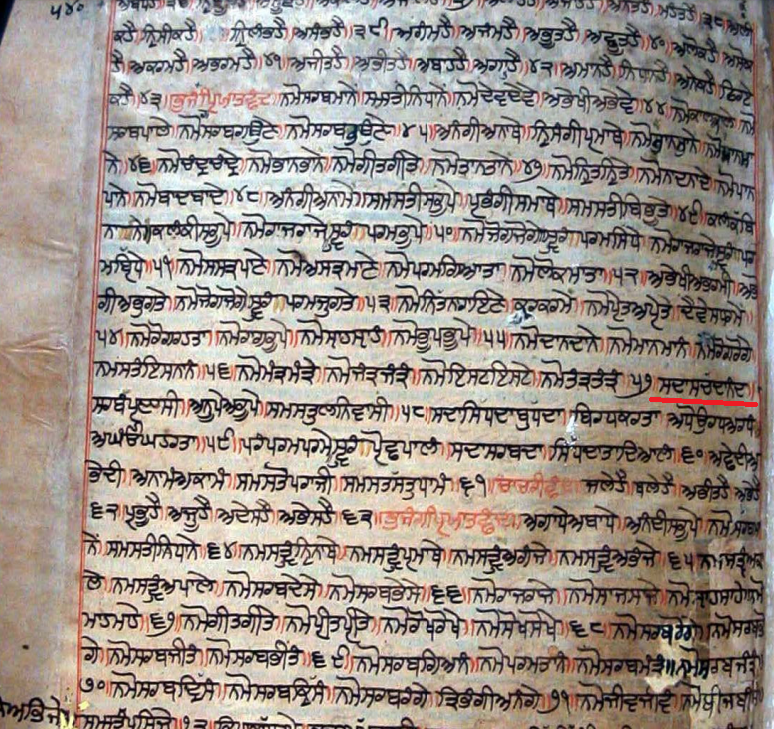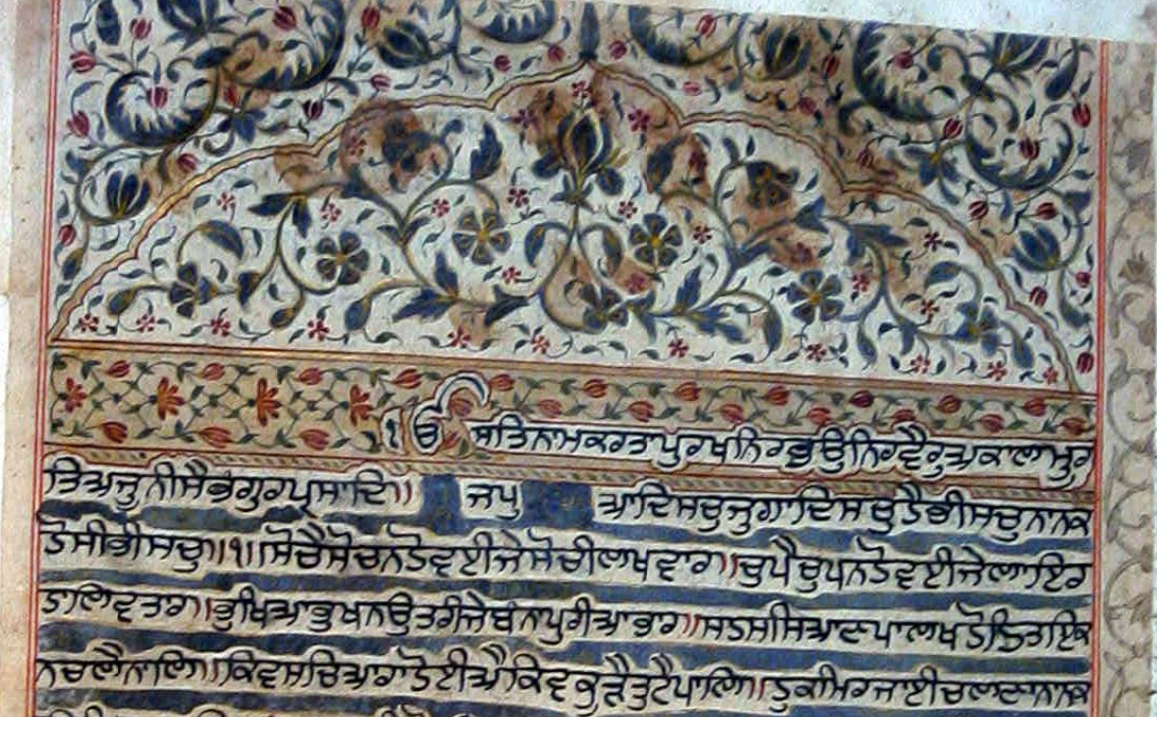Sath[i]naam[u] ... Gurprasaadh[i]
![Sath[i]naam[u] ... Gurprasaadh[i]](/content/images/size/w960/2022/12/guru-har-rai.jpg)
For previous sections, please see here
(ੴ)
ਸਤਿਨਾਮੁ ਕਰਤਾ ਪੁਰਖੁ ਨਰਭਉ ਨਿਰਵੈਰੁ ਅਕਾਲ ਮੂਰਤਿ ਅਜੂਨੀ ਸੈਭੰ ਗੁਰਪ੍ਰਸਾਦਿ
Sathinaam[u] Karthaa Purakh[u] Nirbho[u] Nirvair[u] Akaal Moorath[i] Ajoonee Saibha[ng] Gurprasaadh[i]
-
Padh Arth (word-by-word)
[translated & revised from SGGS Academy’s Japji Sahib Vichaar publication]:
ਸਤਿਨਾਮੁ (Sathinaam[u]): Sachaa (True; free from being destruction) Naam/Name, true name |
ਕਰਤਾ (Karthaa): the Creator of the Universe, Creator |
ਪੁਰਖੁ (Purakh[u]): Omnipresent |
ਨਿਰਭਉ (Nirbhou): Free from fear, fearless |
ਨਿਰਵੈਰੁ (Nirvair[u]): Free from enmity, without enmity |
ਅਕਾਲ (Akaal): Free from death, beyond time, timeless |
ਮੂਰਤਿ (Moorath[i]): Saroop, Form, icon, figurine |
ਅਜੂਨੀ (Ajoonee): Free from birth, without birth and death |
ਸੈਭੰ (Saibhang): Suthae (from Itself) Prakaash, Self-illumined |
ਗੁਰਪ੍ਰਸਾਦਿ (GurPrasaadh[i]): With Great Kirpaa, Guru Di Kirpa Naal; Through Guru’s Grace |
-
TN = Translator’s Note
-
Commentary:
That which is not bound to the three tenses/times: past, future, and present is referred to as ਸਤਿ (Sath[i] ~ True). The One consistent within all 3 states of Jaagrath (Waking state), Supan (Dream state), Sukhopath[i] (Deep Sleeping State) is referred to as Sath[i] [True]. (ਸਤਯਾਚਾਸਾਊਨਾਮ Sathyam-chaa-saaoo-naam) | ਸਤਿਨਾਮੁ (Sath[i]naam[u]): That which has a ਸਤਿ (Sath[i] ~ True) Form, whose can be described as True therefore is referred to as ਸਤਿਨਾਮੁ (Sath[i]naam[u])| (TN: What do we use names for in this world? Behind a name are ideas which help us understand something. For example, the word Sun: we understand it to be a bright glowing fireball in the sky, it is warm, we classify it as a star. All of these characteristics we humans have reserved for the word Sun... thus if we were to describe the form of Vaheguru... we are mentally limited because Vaheguru cannot be understood through classifications such as colour, temperature, shape, size etc. Thus we can only refer to Vaheguru as True. True is the Name of Vaheguru. Nothing else is True as it breaks the definition of being present within all 3 tenses. If we were to point to a plant and ask: "What colour is the plant?" Someone may say green but this is not true in spirituality. Why not? The plant's form was not green in the past [when it was a seed], the plant will become brown [when it dies]. Thus, saying the plant is green is not a spiritually true statement. Are we true? Well, what do we define as ourselves? Are we our bodies or minds? The body had a beginning and an end. So does the mind. So who are we truly?)
-
Question:
why does the ਤ (Thakaar/Thathaa) within ਸਤਿ (Sath[i]) have a ਿ (Sihaaree) ? Other granths do not have that ਿ (Sihaaree)? Only Satguru Ji’s Bani has a ਿ (Sihaaree) on the ਤ (Thathaa/Thakaar) in the word ਸਤਿ (Sath[i]). What is the reason behind this?
-
Answer:
In Sanskrit, the ਤ (Thakaar) has a ਯ (Yakaar/Yayaa) following it, example: ਸਤਯਾ ਗਯਾਨ ਮਨੰਤੰ (Sathy[ng] Gyaana-man[ng]th[ng]). The ਯ (Yayaa/Yakaar) is pronounced as a ਇ (Ikaar). Meaning: Sanskrit’s ਯ/y becomes ਿ /i sound in the common language. Just like ਜਯ ਜਯ (Jay Jay) is written in Sanskrit and is pronounced ਜੈ ਜੈ (Jai Jai). This is why Guru Sahib has written in this way.

The Sat-Chit-Anand Brahm (One Reality-Awareness/Consciousness-Bliss) takes on the form of Maya [Manifesting Power/Creation] and becomes the Doer-Being. Brahm’s Active Consciousness pervades as the energy which gives existence to Creation. Then through Maya, the universe comes to be again and again.
-

That which is ਸਤ (Sath ~ Real) becomes the ਕਰਤਾ (Karthaa ~ Doer) through taking on the Form of Maya. That which does the action of doing, is referred to as the Doer. ਪੁਰਖੁ (Purakh[u]) means Male. That which is not female or impotent. This means that which is pervading everywhere, omnipresent becomes ਪੁਰਖੁ (Purakh[u]).
-
That which is not afraid of another can be referred to as ਨਿਰਭਉ (Nirbhou). The name ‘bhav’ means: being born & dying in this world. That which is free from this is ਨਿਰਭਉ (Nirbhou). That which does not have enmity with anyone and sees everyone equally, that is referred to as ਨਿਰਵੈਰੁ (Nirvair[u]).
-
Whose Form is ਅਕਾਲ (Akaal). That which cannot be killed by anyone, that is ਅਕਾਲ ਮੂਰਤਿ (Akaal Moorath[i]). The name Kaal refers to time. That which is not limited to the age groups: child, adult, or elderly. In the Aek-Akhree Kosh (Encyclopedia of Letters): ਅ (Akaar) refers to Vishnoo, ਕਾ (Kaa) refers to Brahmaa, ਲ (Lakaar) refers to the destroyer Shiv. (TN: In the last section we discussed that all 3 powers which are associated with these 3 deities are actually wielded by Vaheguru. The Power of Sustaining/Nourishing/Protecting belongs to Vaheguru, the Power of Destruction/Removal belongs to Vaheguru, and the Power of Creation belongs to Vaheguru).
-
ਕਰਤਾ ਪੁਰਖੁ (Karthaa Purakh) refers to being the One that takes on these 3 forms and therefore ਅਕਾਲ ਮੂਰਤਿ (Akaal Moorath[i]). The One who is not subject to the 8.4 Million Births is referred to as Ajoonee. The name ‘Aj’ also refers to the Unity of Brahma [Creation], Vishnu [Sustenance] , Mahesh [Destruction]. (TN: Vaheguru is the Wielder of All Powers).
-
ਸੈਭੰ ਸਵੈਯੰਭੂ (Saibhang Swambhoo) is written as ਸੈਭੰ (Saibhang) here.
That which exists on its own is referred to as ਸੈਭੰ (Saibhang).
The One who destroys hundreds of changing/dynamic elements.
-
How do we bring such a Form of this type of ਕਰਤਾ ਪੁਰਖੁ (Karthaa Purakh[u]) to our concentration? Meaning how can we know/understand this ਕਰਤਾ ਪੁਰਖੁ (Karthaa Purakh[u]). How can this form become pleased with us and give its Darshan?
To answer this question, Guru Nanak Dev Ji tell us ਗੁਰਪ੍ਰਸਾਦਿ (Gurprasaadh[i]): Satguru Ji are pleased when we do their Seva in our minds, actions, and words.. When Satguru sees a Sikh suffering then they compassionately bless them.
-
ਪ੍ਰਸਾਦਿ (Prasaadh[i]) refers to being pleased but also compassion/mercy.
-
‘Gur’ = ‘Go’ means: darkness, which refers to ignorance.
‘Ru’ means: radiance/glowing, which can refer to spiritual wisdom/enlightenment. That which destroys ignorance by blessing with spiritual wisdom is known as Gur.
-
This first Salok is a Manglacharan from Dhan Guru Nanak Dev Ji Maharaj.
-
Guru Arjan feature this Manglacharan in Their Bani as well.
What kind of Salok is this? They see nothing as priceless in this world besides liberation. Nothing takes priority over this State of Bliss. They always remain in Mangal = Spiritual Happiness/Bliss. Concentrate upon the form of Sri Guru Nanak Dev Ji when reciting this Manglacharan.
-

What is a ਮੰਗਲਾਚਰਨ Manglacharan?
There are 3 types of Manglacharan in granths.
1) Where a ਨਮਸਕਾਰ (Namaskaar ~ Reverence/Bowing Down) is happening that is called a ਨਮਸਕਾਰ ਆਤਮਕ ਮੰਗਲ (Namaskaar-Aathmak Mangal).
2) Where your Beloved is being exalted/praised (ਜੈ ਪਦ ~ Jai Padh), that is referred to as ਅਸ਼ੀਵਾਦ ਆਤਮਕ ਮੰਗਲ (Asheervaadh-Aathmak Mangal).
3) The third is ਵਸਤੂ ਨ੍ਰਿਦੇਸ਼ (Vasthoo-Nridhaesh),
it is where the Beloved’s Form/Aspects are described.
-
A Manglaacharan is featured in the beginning of a granth where the Divine-Beloved is spoken of. The purpose is to ask for help in order to complete the Granth without any obstacles. This part of Japji Sahib features a ਵਸਤੂ ਨ੍ਰਿਦੇਸ਼ ਮੰਗਲ (Vasthoo Nridhaesh Mangal), the Salok features names/qualities of the Beloved. When these names are explained then we discuss the qualities and form of Paarbraham Vaheguru. This is why it is also a ਵਸਤੂ ਨ੍ਰਿਦੇਸ਼ ਮੰਗਲ (Vasthoo Nridhaes Mangal). ਅਸ਼ੀਵਾਦ ਆਤਮਕ ਮੰਗਲ (Asheervaadh-Aathmak) and ਨਮਸਕਾਰ ਆਤਮਕ ਮੰਗਲ (Namaskaar-Aathmak Mangal) are never standalone, they always also feature a ਵਸਤੂ ਨ੍ਰਿਦੇਸ਼ ਮੰਗਲ (Vasthoo-Nridhaesh Mangal). How are ਜੈ (Jai) and ਨਮੋ (Namo) also featured? They exist dependent on the use of names, qualities, and description of the form of the Beloved yet ਵਸਤੂ ਨ੍ਰਿਦੇਸ਼ (Vasthoo Nridhaes) is independent. ਗੁਰਪ੍ਰਸਾਦਿ (Gurprasaadh[i]) is a descriptor of the Guru, which allows us to attain Parameshar. This is referred to as a Manglacharan. Calling upon Vaheguru’s Name destroys many obstacles.
-
This Manglacharan has been explained, now the ਅਲੰਕਾਰ (Alankaar's) will be discussed.
(TN: In this following analysis, Kavi Ji are appreciating the Beauty of Gurbani through a traditional Indian poetic lens)
-

Alankaar’s (literary/poetic devices)
-
ੴ (Ik Oankaar) features a ਬਿਸ਼ੇਖ ਅਲੰਕਾਰ (Bishaekh-Alankaar)
Quality: Where in one place contains a variety,
that is referred to as ‘Bishaekh’ which brings two to One.
How? Here ‘Ik’ takes on ‘Oankaar’ by pervading all places,
That is why this can be considered as having a Bishaekh-Alankaar.
-
ਉਲੇਖ ਅਲੰਕਾਰ (Oulaekh-Alankaar) is also present in the Oankaar:
Quality: Ik can be interpreted by multiple traditions,
this fits into the quality of ‘Oulaekho’ Alankaar
How? Ik-Oankaar is recognized by [more than] 7 different traditions, this is why Oulaekh-Alankaar can be considered here.
-
The following will explain how ਅਕਾਲ (Akaal Moorath[i]) and (Sath[i]) can be seen as ਜਾਤਿ (Jaath[i] Alankaar) and ਨਿਰਭਉ (Nirbhou) and ਨਿਰਵੈਰੁ (Nirvair[u]) can be seen as ਸੁਭਾਵੋਕਤ ਅਲੰਕਾਰ (Subhaavokath[i] Alankaar). Quality: Where the form of something is explained,
so know that as ਭੂਪਨ ਜਾਤਿ (Bhoopan Jaath[i])... and thus, a Subhaavokath Alankaar,
-
ਗੁਰਪ੍ਰਸਾਦਿ (Gurprasaadh[i]) contains a ਪ੍ਰਸਨਖਯਾ ਅਲੰਕਾਰ (Prasankhyaa-Alankaar). Moving away from previous knowledge understood from all other places, and then gaining a new understanding due to the addition of ਗੁਰਪ੍ਰਸਾਦਿ (Gurprasaadh[i]) is referred to a Prasankhyaa Alankaar.
Quality: To stop in one place and to pull attention towards something else...
This stopping and redirection is a quality called Prasankhyaa. (TN: Gurprasaadh[i] is a Name describing Guru Sahib like the previous descriptors but it also is a verb/action... through Guru’s Kirpa we receive understanding of this Ik)
–
TN: Please forgive any mistakes. Please suggest any additions/suggestions. Please subscribe to be able to see our posts right when we publish.
Guru Panth Ka Daas,
~Aaeenaa

